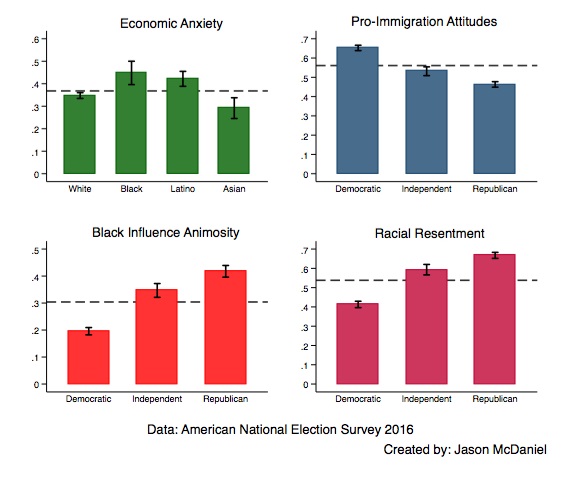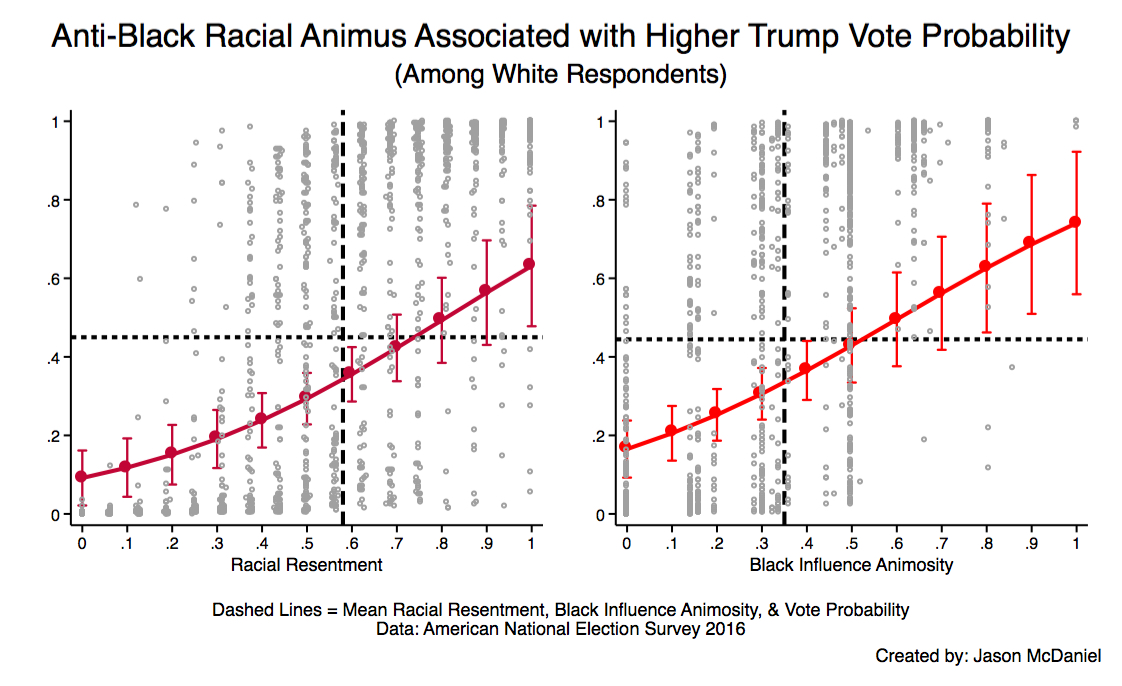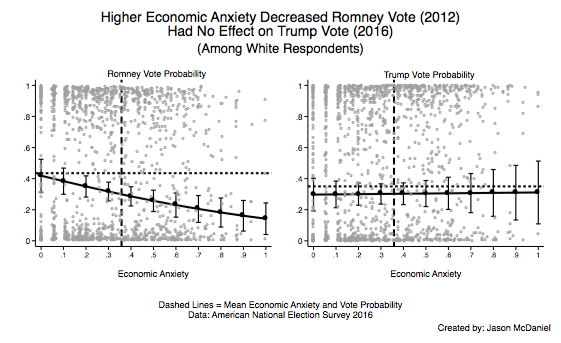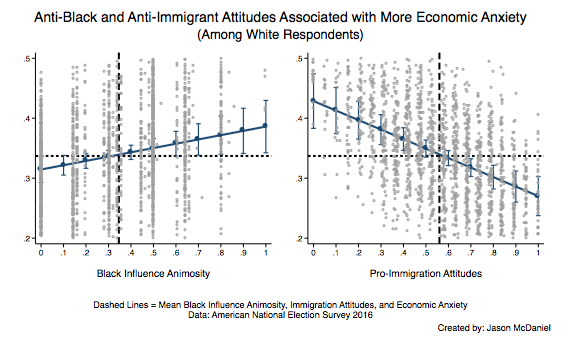Was Donald Trump elected because of racism or economic anxiety? Few questions about the 2016 election have generated more analysis. As we’ve previously written, it is clear racism propelled Trump to the Republican nomination. But how did the racial resentment that powered Trump’s ascent differ from the support for Republican candidates in prior elections? And what was the relative importance of economic peril to voting in 2016 compared to several different types of racism and racial animus exhibited by voters?
The answers can be found in the comprehensive American National Election Studies pre- and post-election survey of over 4,000 respondents, which we analyzed to explore the impact of racism and economic peril on 2016 voting behavior. The results are clear, and move a long way towards settling this debate.
Our analysis shows Trump accelerated a realignment in the electorate around racism, across several different measures of racial animus—and that it helped him win. By contrast, we found little evidence to suggest individual economic distress benefited Trump. The American political system is sorting so that racial progressivism and economic progressivism are aligned in the Democratic Party and racial conservatism and economic conservatism are aligned in the Republican Party.
How We Performed The Analysis
In order to get at how various dimensions and aspects of racial animus and xenophobia impacted voting in 2016, we created three different indexes using questions from the newly released ANES 2016 Time Series Survey. First, we created a racial resentment scale, based on a series of four questions developed by Lynn Sanders and Donald Kinder. Racial resentment measures dog-whistle or color-blind forms of racism, such as the belief that black people need to simply “try harder” to be successful in America, or that generations of discrimination do not hold back black Americans. However, some have criticized the concept of racial resentment and the various questions designed to measure it as essentially equating conservative beliefs and “race-neutral” principles with racism and racial animus. We believe that such concerns are exaggerated and that racial resentment captures an important dimension of racial animus in American politics.
Nonetheless, in order to speak to such concerns, we created a second measure we call “black influence animosity” derived from questions that more directly examine voters’ views about whether the US government favors black people over white people and how much influence black people have in US politics.
Third, we created a scale based on views about immigration—such as whether one believes immigrants are more likely to commit crimes and take away jobs. We created a stereotyping scale which measures views like believing people of color are more violent or lazier than whites, but it was not included in our final models because it did not predict voting behavior.
Popular
"swipe left below to view more authors"Swipe →
In addition to our racial attitude measures, we created a scale to measure perceptions of personal economic peril or anxiety, which includes respondents’ answers about their ability to make house payments and pay for medicines and other important costs, and worries about job security and personal finances.
These specific queries are more useful than broader questions like someone’s views on the economy, which tends to be tainted by partisanship. On the economic peril scale, there were no differences across party controlling for age, income, education, race and gender. In contrast, views on whether the economy had gotten worse in the past year were strongly influenced by partisanship, controlling for other factors.
The charts below show average values for our variables by race and party. Although the plight of economically insecure white people has been placed at the center of much of the analysis of the election, our analysis indicates that black and Latino respondents tend to express significantly higher levels of economic peril compared to whites or Asians, who as a group, express below average levels of economic peril.
There is very little difference between Democratic and Republican partisans on this scale. Independents, however, express significantly higher levels of economic insecurity. Although Republicans and Democrats do not, on average, express different levels of economic anxiety, there are clear differences between Republicans and Democrats on the measures of racial attitudes towards African-Americans and the measure of pro-immigration attitudes. Democrats express dramatically lower anti-black attitudes on both scales compared to Republicans or Independents. On the black influence animosity scale the divide between Democrats and Republicans is even greater than on the racial resentment scale. The average score of Obama to Trump voters on the black influence animosity scale (.43) was far more similar to Trump voters (.48) than Clinton voters (.21). Obama to Trump voters also had an average score the immigration scale (.44) closer to Trump voters (.43) than Clinton voters (.69). Unsurprisingly, Republicans express significantly lower pro-immigration attitudes compared to Democratic partisans.
For the purposes of testing the relative impact of individual economic anxiety and racial animus, the ANES survey is ideal. We modelled a few different outcomes: what predicts votes for Trump and what predicted an Obama to Trump flip. The sample of Obama to non-voters or third-party voters was too small to study. All of our models also control for income, age, gender, religiosity, education, ideology and party identification.
What We Found: It’s Racial Animus, Not Economic Anxiety
In our models, racial attitudes towards blacks and immigration are the key factors associated with support for Trump. The way that these variables impact Trump support can be seen in the charts below. Both racial resentment and black influence animosity are significant predictors of Trump support among white respondents, independent of partisanship, ideology, education levels, and the other factors included in the model. The results indicate a probability of Trump support higher than 60 percent for an otherwise typical white voter who scores at the highest levels on either anti-black racial resentment or anti-black influence animosity. This compares to less than 30 percent chance for a typical white voter with below average scores on either of the two measures anti-black attitudes. There is approximately a 10 percent probability of a Trump vote for an otherwise typical white voter at the lowest levels of racial resentment.
The effect of immigration attitudes for white people is even stronger than anti-black attitudes. The results predict an approximately 80 percent probability of voting for Trump for an otherwise average white person with the most anti-immigrant attitudes, compared to less than 20 percent for a white person with the most pro-immigrant attitudes. To put these results in context, the magnitude of the effects of each of the three variables—racial resentment, black influence animosity, and immigration attitudes—is comparable to the effect of partisan identification. The change in probability of a Trump vote for a white person with the highest to the lowest levels of racial animus is similar to changing their party identification from Republican to Democratic.
Our results also indicate that economic peril was not a significant predictor of voting for Trump once either racial attitudes or immigration attitudes are included in the models. As shown in the chart below, Trump vote probability for an average white person does not change regardless of whether they express high or low levels of economic insecurity.
This result is markedly different in comparison to the 2012 election, when higher levels of economic anxiety was associated with lower levels of support for Mitt Romney among the average white person. In addition to the lack of any economic anxiety effect among white people, our model indicates that the only detectable economic anxiety effect is among black respondents, who were even less likely to vote for Trump as their level of economic peril increased. In fact, for the average black person, economic peril was the predictor variable that had the strongest negative impact on likelihood of supporting Donald Trump.
Our final set of results put an even finer point on the dubious nature of 2016 analyses that emphasize white economic anxiety. For one, as shown above, Latinos and African-Americans scored higher on our economic peril scale than did whites. Any analysis of the role of economic anxiety during the 2016 election that fails to consider the experience of Latinos and black people can only be called misleading.
When we model the factors that predict whether someone expresses economic anxiety, we find that Republicans have significantly lower levels of economic anxiety compared to Democrats and Independents, and that there is no significant difference in economic peril between Clinton and Trump voters. Most importantly, as shown in the chart below, the two strongest predictors of white economic anxiety are attitudes towards immigration and black-influence animosity. Among a typical white person, anti-black and anti-immigrant attitudes feed negative perceptions of personal economic hardship. Not only is there no effect of income or economic anxiety for white people on Trump support once racial attitudes are taken into account, there is strong evidence that these racial attitudes cause economic anxiety rather than the other way around. A result that is consistent with earlier research by Michael Tesler, the influential scholar of race and politics.
This is not to say that fundamental economic conditions played no role in the election. Research suggests that the housing crisis may have affected voting patterns. Other research has linked poor health outcomes and trade to Trump voting. Other work has found that financial crises increase the electoral success of far-right parties. People do not experience politics as atomic units, but as part of communities. However, it is very difficult to see in the survey data any evidence that individual personal hardship among whites played a powerful role in the election.
The Politics of the Future is the Politics of Race
So what’s going on? Well, it seems Trump is both the product, and a further catalyst of, the increasing sorting of parties along racial attitudes.
What does sorting mean? One example from history is abortion: for a long time there were pro-life Democrats and pro-choice Republicans, but parties have sorted so that party identification strongly predicts views on abortion. Similarly, there used to be racially liberal Republicans (think of George Romney) and racially conservative Democrats (think Robert Byrd). As recently as 2000, George Bush discussed micro-agressions at the Republican National Convention and pushed for immigration reform, though his presidency was defined by anti-Muslim fearmongering and callousness towards the victims of Katrina.
Still, as other research has shown, many low-interest voters still had trouble distinguishing parties in terms of attitudes about aid to black Americans as late as 2008. Obama’s election and the subsequent backlash ensured that very few racial progressives would vote for Republicans and very few racially resentful individuals would vote for Democrats. As the chart above shows, individuals are now well-sorted into parties and Republicans score nearly twice as high on our explicit racial resentment scale.
The one-two punch of Obama’s presidency and Trump’s candidacy sent a clear signal to voters what the parties stood for: diversity on one side, resentment on the other. Trump built upon a decades-long campaign to erase support for the safety net by racializing government programs but extended it further by openly demonizing people of color. Graphs from political scientist Thomas Wood show this relationship clearly: voters are increasingly sorted along the lines of racial resentment. At the same time, the role of income has been twisted: “While the wealthy are usually most likely to vote for the Republican, they didn’t this time; and while the poor are usually less likely to vote for the Republican, they were unusually supportive of Trump.”
It’s likely that political elites (party leaders, activists, media organizations) will continue on the current path and the issue of identity will fully map onto the current political divides. Economic conservatism and white nationalism will become more fully intertwined for Republicans, as will racial and economic equity for Democrats. Republicans have shown little interest in attempting to hold back Trump’s openly racist rhetoric. On the other side, few Democrats have proposed abandoning civil rights (and those who have met intense backlash). Democrats may press forward with an economic, racial and gender progressive agenda, while Republicans continue to tie economic conservatism to white identity politics.
Another possible outcome would be for economic issues to simply further fall off the political map, with identity becoming the central battleground in American politics. This would involve Democrats reducing their commitments to economic equality, while Republicans embrace a sort of ethnonationalism. For instance, Trump could try to follow the pathway of Viktor Orban in Hungary, nationalizing industries to lower consumer prices while also spouting xenophobic rhetoric. Another model would be the Law and Justice party in Poland, which has melded anti-Semitism and a populist agenda including child tax benefits. Trump has made signals in this direction—for instance his push for a big infrastructure bill.
However, so far, nothing like this has materialized, and powerful interests within the Republican Party would strongly oppose any action in this direction. For this reason, we think this realignment is unlikely with the current status quo—Trump has expressed no interest in attempting to make it happen, nor has any Republican statewide elected officials.
Though such a realignment is unlikely, progressives should be concerned about such an outcome for two reasons: First, the confluence of racial and economic inequality in the United States means that there are more poor whites than rich non-whites available to migrate between party coalitions—a fact that may have been overlooked by the Clinton campaign. Second, without economic redistribution, progressive goals on LGBT rights, racial justice, and gender equity are unattainable. Civil rights without economic redistribution will leave many behind, from transgender homeless kids to home healthcare workers.
The right, however, has powerful incentives to continue increasing the salience of identity, which will mask their regressive politics.






